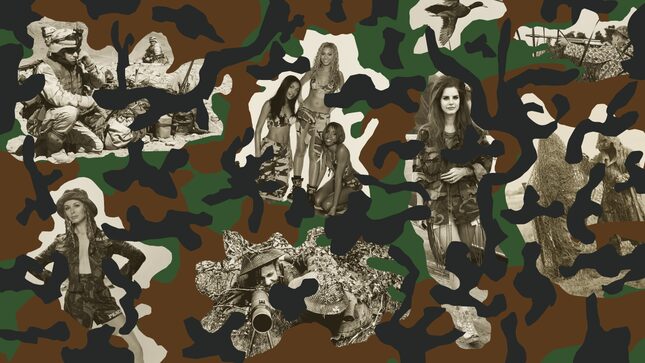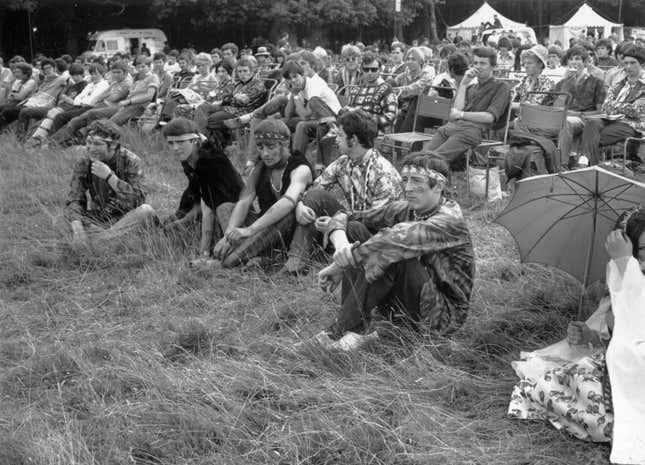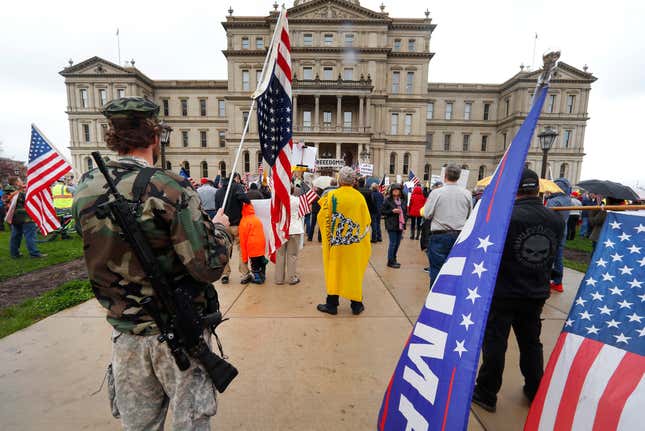The Aggressive Visibility of Camouflage
In Depth
Illustration: Elena Scotti (Photos: Getty Images)
When the Trump Administration released in January the army green, camouflage-print designs for their Space Force uniforms, it took about five minutes for the dunking to begin. It was funny, I guess, to see the sixth branch of the American military stand at attention in their Air Force knockoff fatigues and talk about everything they still needed to figure out. “It’s going to be really important that we get this right,” said a representative. “A uniform, a patch, a song… There’s a lot of work going on toward that end.”
Meanwhile, Twitter comedians trotted out the jokes about outer-space jungles and Avatar. How dumb is Donald Trump, was the subtext, how dumb are these people, that they would forget the point of camouflage entirely? Camouflage is supposed to keep troops hidden against the greenery. It’s all about disguise. Don’t they know that?
That is technically true, but I don’t think the Space Force uniforms were a dumb design decision at all, that someone simply forgot about the wide, vast, dark nature of space. I think this was a canny decision, designed to make people talk. More importantly, this print was chosen to showcase power, might, force. Because camouflage isn’t about hiding. It’s about being visible.
It took humans until the 1800s to begin to latch on to the idea that there might not be some grand tailor in the sky, sewing skin suits for all animals and insects, adding a little flair here, a little tuft of feathers there. Instead, argued British naturalist Sir Edward Bagnall Poulton in his 1890 book The Colours of Animals, creatures chose their own shades through the process of sexual selection. Some birds, like the mandarin duck, likely mated their way into fabulous permanent outfits. Some snakes, like the aptly named emerald tree python, probably survived long enough to breed by blending into the vivid greens of the jungle around them. In the natural world, camouflage works to help animals sneak up on their prey undetected—or to escape from their predators—through a combination of color and pattern.
Human reliance on camouflage has a much shorter history. Up until the mid-1800s, professional soldiers mostly wore colorful uniforms, clothing that revealed their all-important allegiance to their rulers clearly and quickly—think Prussian blue or lobsterback red. As war began to change, shaped by new technologies like sharpshooting and the demands of colonial occupation, so did the outfits. Governments began outfitting their soldiers in khaki, green, and other neutral tones in the late 19th century; camouflage fabric came into widespread use in the 1920s and 1930s. For the first half of the 20th century, it made perfect sense for soldiers to wear army green fatigues. Troops were fighting wars in jungles with guns and knives and hand grenades. They used camouflage to help them be more effective predators, less enticing prey.
After the United States dropped two atomic bombs on Japan and entered a Cold War with the Soviet Union, the prospect of nuclear conflict meant that war and therefore camouflage were less directly tied to landscape. The American government continued to design new uniforms for each war, including the wars in Iraq, but the value of the garments had become harder to parse. They helped the soldiers blend into the desert, certainly, but they also provided a striking contrast between the camo-clad American military and the civilian clothes of the retreating Iraqi army. While guerilla groups still use camouflage effectively, and militias of course like to don the cloth, large-scale warfare had begun to outpace the print. Drone warfare furthered this transition, as did the 21st-century invention of online warfare. We target people differently now. We hurt them in new ways. We kill and seize power in new forms. We’re an inventive species.
Yet camo still has its uses, and to this day, militaries continue to develop new camouflage prints they think will be more useful in combat, more effective at tricking the eye and hiding the predator. Landscape continued to shape the look of specific camouflage of every 20th-century conflict: The Vietnam War was fought in swamps, jungles, and fields, making camouflage an important military tool. American troops started out wearing solid-color drab green uniforms, but by the end of the war, they were dressing in fabric adapted from a Vietnamese tiger stripe pattern. This pattern was denser and more intricate than the earlier American-made camos (like the “frog” pattern that was briefly adopted by the military in the 1950s). The 1990s, too, saw new camo prints designed specifically for desert warfare. According to USA Today, “a six-color ‘chocolate chip’ cammie” became associated with war in the Middle East, replacing the earlier, greener versions in the minds of many Americans.
Over the decades, camo has become imbued with so much meaning; it’s so easy to read. If you see someone in military fatigues, you may already know quite a bit about their life, their habits, their political allegiances. For some people, this is a good reason to avoid wearing camouflage. In 2019, Claire Gibson wrote for Marie Claire about how, after having grown up on a military base, wearing camo casually felt like “stolen valor.” Others avoid wearing it because we don’t support the American military machine, because we don’t want our bodies to remind people of war, of death. But those who do want to wear it don’t have to search far—it seems like every big-box retailer currently sells their own camo-printed leggings, tank tops, and hoodies. It’s particularly popular in athleisure and workout gear, so if you want to look more hawkish on your daily jog, you can.
Sometimes, camo occupies the runways, only to fall out of favor then return, yet again, in new colors and fabrics and cuts. It tends to coincide with periods where America is actively at war abroad. During World War II, Town & Country magazine ran a cover that showed a model in a camo print shirt dress, and in the ’60s hippies got their hands on surplus fatigues and “wore them as symbols of resistance to protest against the war effort,” explained curator Emma McClendon to a writer for The Zoe Report. It was a subversive move when women paired camouflage with daisy prints and peace signs and wore them around the streets of San Francisco, creating a clear contrast between symbols, between ideologies. For most of the 20th century, camo came and went in big swings. But then we entered a period of forever war, and it seems like camo hasn’t truly gone away since.

I was a kid in the ’90s, but I remember the slime green, sporty pink, and electric blue camouflage patterns of the decade. I remember that bratty, Mountain Dew-scented moment in fashion, when office-bored men got frosted tips and Jeeps and mall-bound women paired tube tops with low-rider jeans. N*Sync was photographed in matching camouflage pants, each in a different bold color—purple, blue, red—and the members of Destiny’s Child made army-green camo look somehow feminine, subversive, and sexy. It lingered on through the 1990s and early aughts, in streetwear and on sk8r bois and in the irony-intoxicated pages of Vice. The pattern has a long history in hip-hop, one that—like the hippies who wore them even as they protested against Vietnam—exists in tension with America’s national narrative about its war powers.
Of course, at the same time, there were plenty of rural types who wore it, divorced from the dictates of trendiness, whether out of a desire to blend in with the forest or a desire to pass for a soldier, I’ll never know. They, too, wore bright camos and faded camos. Think of the all-camo iconography of the late 2000s pop culture sensation Duck Dynasty, which used camouflage as an in-your-face statement of identity, working with RealTree and selling merch announcing “My Favorite Color is Camo” (before the show collapsed after patriarch Phil Robertson’s offensive remarks about race and gender, that is). There’s a Dollar Store a few minutes from my home in rural Maine, and they still sell neon-bright camo shorts for women. I expect they always will.
In 2018, GQ declared that “Camoflague Is Back (Yes, Again)” and told readers how to best wear the trend. “If it feels to you like camouflage prints are a trend every season, you’re not losing your mind,” wrote Megan Gustashaw. “The motif is masculine, muted, and not complicated to reproduce on the cheap, which makes it too tempting for designers and brands both high and low to pass it up.” What made this particular year’s trend notable, Gustashaw argued, was that designers like Valentino and Philipp Plein were once again showing colorful and shimmery camo, not that earthy, drab shit. She went on to tell readers how to wear both neon orange camo and army green—both kinds, it turns out, were on the runways. This year’s camo wasn’t different from last year’s, after all.
Camo is supposedly in right now and “back for good,” if you believe print glossies, fashion websites, and Victoria Beckham. Some people do make it look damn good. Yet I personally can’t stomach it, as I’m sure you’ve gathered. Ever since moving to a rural area, I’ve been put off by camo, by the desire so many people seem to have to play soldiers, play apocalypse survivors, play hunters. As someone who frequently comes into contact with these types of characters, I have learned through experience that white guys in camo jackets are probably best avoided. Camo, you’ll notice, is prominent in pictures from every “Reopen America” rally, including when armed protestors stormed the Michigan statehouse, hollering about the tyranny of Governor Gretchen Whitmer. Hiding certainly wasn’t on their agenda; their whole plan revolved around being seen.

A few years ago, I met a veteran of the invasion of Afghanistan. I was attending a four-day Appalachian Mountain Club wilderness guide-training course, and over the first few days, we struck up a tentative friendship. He seemed lonely, and I was a bit out of my depth, skills-wise, so he took pleasure in sharing his knowledge. He was an avid naturalist. He wore head-to-toe camo print and could identify birdcalls. He was also, I found out on my last day of the course, a true believer in gun culture.
We didn’t fight about it, not really. We talked a little about how he believes teachers should be armed, and I don’t want my husband to carry a gun to school. He told me he is always on guard, and everyone should be. We live in a world where you might get shot, and you should act accordingly. In his world, we’re all soldiers, every single American. We’re all cannon fodder.
I left those woods and went back to my woods, where we keep the land posted against hunters. I don’t wear camo because I’m not like that soldier, because I don’t support the military, because I don’t want our tax money to go towards causing more death rather than saving lives. But I also don’t wear it because it’s not safe. In Maine, where hunters are legally entitled to any territory that isn’t specifically marked off-limits, people have been mistakenly shot and killed; up here, a camo print Sandy Liang teddy coat could cost me my life. I could blend in too well, look too much like a tree or a deer. I’m forced to put on blaze orange and hope for the best, because no matter how many signs we post, there are always hunters in our woods with rifles and shotguns and tree stands. It’s their right.